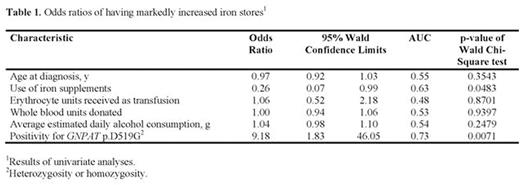Abstract
GNPAT (chromosome 1q42.2) encodes the peroxisomal enzyme glyceronephosphate O-acyltransferase. In a previous study, DNA of men with hemochromatosis and HFE p.C282Y homozygosity and either markedly increased iron stores or normal or mildly increased iron stores were evaluated with exome sequencing. Positivity for the GNPAT polymorphism p.D519G (rs11558492) was significantly greater in men with markedly increased iron stores (McLaren CE et al., Hepatology 2015;62:429-39). This result suggests that the p.D519G is a candidate modifier of iron phenotypes in p.C282Y homozygotes. To learn more, we examined associations of p.D519G, age, iron-related variables, and daily alcohol consumption with iron stores in p.C282Y homozygotes classified by extremes of iron overload phenotypes.
We defined markedly increased iron stores as serum ferritin >1000 µg/L and either hepatic iron >236 µmol/g dry weight or mobilizable iron >10 g by induction phlebotomy (men and women). Normal or mildly elevated iron stores were defined as serum ferritin <300 µg/L and either age ≥40 y with ≤2.5 g iron removed by induction phlebotomy or age ≥50 y with ≤3.0 g iron removed by induction phlebotomy (men only). We first compared general characteristics of participant subgroups using univariate methods. Then, using multivariable logistic regression, we evaluated associations of markedly increased iron stores with the following six variables observed at diagnosis of hemochromatosis that might account for markedly increased iron stores: age; iron supplement use (dichotomous); number of whole blood units donated; number of erythrocyte units received as transfusion; daily alcohol consumption, g; and p.D519G positivity (heterozygosity or homozygosity).
There were 56 participants (53 men, 3 women), of whom 41 (38 men, 3 women) had markedly increased iron stores and 15 others had normal or mildly increased iron stores (all men). The mean age of the 56 participants was 55 ± 10 (SD) y. Prevalences of swollen/tender 2nd/3rd metacarpophalangeal joints and elevated serum levels of aspartate or alanine aminotransferase were significantly greater in participants with markedly increased iron stores. Only participants with markedly increased iron stores had cirrhosis proven by biopsy.
Odds ratios of having markedly increased iron stores for each of the six variables, as determined by univariate logistic regression, are displayed in Table 1. In the multivariable analysis, p.D519G positivity was the only exposure variable significantly associated with markedly increased iron stores (odds ratio 9.9, 95% CI [1.6, 60.3], p = 0.0126). Area under the curve for the multivariable logistic regression analysis was 0.82.
We conclude that GNPAT p.D519G is strongly associated with markedly increased iron stores in p.C282Y homozygotes after correction for age, iron-related variables, and daily alcohol consumption. It remains unknown whether p.D519G directly enhances iron transport into the blood by absorptive enterocytes, indirectly augments iron absorption by suppressing hepcidin, or is linked to a putative iron absorption promoter on chromosome 1q.
No relevant conflicts of interest to declare.
Author notes
Asterisk with author names denotes non-ASH members.


